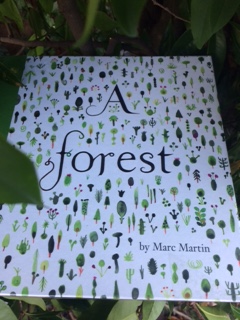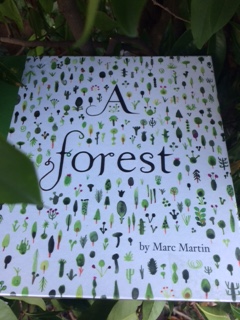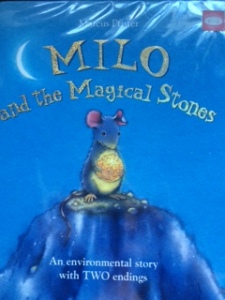A forest by Marc Martin immediately captured my attention with the creatively painted forest on the front cover.

The tiny trees that envelop the front cover , each one completely different from each other, have been drawn with water colours, texta, pencil and ink.
A forest tells a story through simple words and captivating pictures about a forest being destroyed due to human greed but then growing again through human care. A true story of hope and empowerment.
I loved reading this story to my children and they enjoyed listening and looking at the illustrations. It is a poignant story and one which helps to grow awareness of the importance of the natural world just outside out doorstep.
It’s a brave story with tender words and memorable images. It’s a must read for anyone who loves a good picture book with a message of hope.
So, how can we have fun with this story before, during and after we have read it?
- Tell the story without any words – ask your child or class to tell their own story. Storytelling is a timeless art, increases vocabulary and imagination and is a lot of fun. Children can see the story how they wish to see it. Give it a go.
- Using measurement skills, work out how many trees per cm2. Students can attempt to work out what this would look like if the scale was 1cm2=1km2. Research different forests of Australia and the size of them. Predict how many different trees would be in these spaces & perhaps even the variety of trees (Fostering the importance of biodiversity)
- Make tree patterns, not only learning about different types of patterns but also exploring different types of trees around the school or neighbourhood!
- Measure different tress that are in the school grounds or the local park. This could even be monitored over the year to see how they all grow differently.
- How many different types of trees are in the local area? Create different data displays.
- Create your own forest – perhaps an Australian version (rainforest, eucalyptus forest, mangrove, melaluca etc) . Or create your own city – research cities of Australia and the world. Look at the lines used in the buildings and recreate your own using texta.
Thinking skills & sustainability
- Compare the differences between the two groups of people portrayed in this story. Link this to people who are in our world. Try to walk in both shoes and work out why people make these decisions and why they think they are doing the right thing OR even why people do things even though they know they are being destructive to the natural world or other people.
Links:
Literacy
Experiment with text structures and language features and their effects in creating literary texts, for example, using imagery, sentence variation, metaphor and word choice (ACELT1800),
Create literary texts using realistic and fantasy settings and characters that draw on the worlds represented in texts students have experienced (ACELT1612)
Create literary texts by developing storylines, characters and settings (ACELT1794)
Create imaginative texts based on characters, settings and events from students’ own and other cultures using visual features, for example perspective, distance and angle (ACELT1601)
Create events and characters using different media that develop key events and characters from literary texts (ACELT1593)
Recreate texts imaginatively using drawing, writing, performance and digital forms of communication (ACELT1586)
Retell familiar literary texts through performance, use of illustrations and images (ACELT1580)
Mathematics
Sort and classify familiar objects and explain the basis for these classifications. Copy, continue and create patterns with objects and drawings (ACMNA005)
Measure and compare the lengths and capacities of pairs of objects using uniform informal units (ACMMG019)
Create displays of data using lists, table and picture graphs and interpret them (ACMSP050)
Identify symmetry in the environment (ACMMG066)
Choose appropriate units of measurement for length, area, volume, capacity and mass (ACMMG108)
Calculate perimeter and area of rectangles using familiar metric units (ACMMG109)
Solve problems involving the comparison of lengths and areas using appropriate units (ACMMG137)
Visual Arts
Use and experiment with different materials, techniques, technologies and processes to make artworks (ACAVAM107)
Use materials, techniques and processes to explore visual conventions when making artworks (ACAVAM111)
Explore ideas and practices used by artists, including practices of Aboriginal and Torres Strait Islander artists, to represent different views, beliefs and opinions (ACAVAM114)
Sustainability


